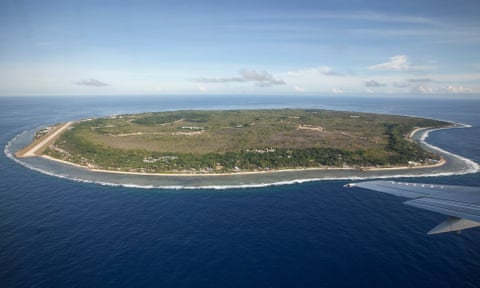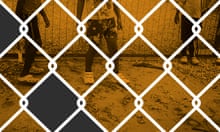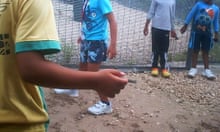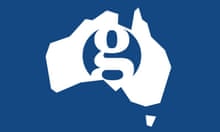Australia has twice used Nauru – and its beholden and broke government – as a remote site for the “offshore processing” of people who seek asylum and protection. What began as a hurried political response to the arrival of one boat, the MV Tampa, on Australia’s northern horizon has metamorphosed over a decade and a half into a standing permanent policy, with the support of both the country’s major political parties.
It is current government policy that no person who arrives in the country by boat seeking asylum (plane arrivals are not subject to “mandatory detention”) is ever settled in Australia. Instead, they are sent to Nauru, or to Papua New Guinea’s Manus Island, for “offshore processing”, a bleak dysphemism because no genuine resettlement ever takes place.
In effect, people accused of no crime are warehoused in appalling conditions in arbitrary and indefinite detention. Dozens of countries, the United Nations, and rights groups including Amnesty International and Human Rights Watch, have documented and condemned the illegal detention.
In comparison with the size of the world’s forced migration challenge, the numbers are tiny. The latest statistics, for the end of June, show there are 442 asylum seekers and refugees living in the Nauru “regional processing centre”, including 49 children. Several hundred more live “in the community” of Nauru. They fall outside the scope of the government’s statistics but remain stuck on the tiny island. The “travel documents” some have been issued are not travel documents at all. They do not allow their holders to travel anywhere.
More than three-quarters (77%) of those forcibly sent by Australia to Nauru whose asylum claims have been assessed have been found to be refugees. They have a “well-founded fear of persecution” and are legally owed protection. But no refugees will be resettled permanently on Nauru. The island’s government has avowedly refused to let anyone stay longer than five years. Other places will need to be found. So far the Australian government has found only one other country willing to take part in this state-sponsored “country shopping”: Cambodia. At a cost of more than $40m, it has managed to resettle one person. A single Rohingyan man.
The first Nauru experiment began in 2001, after the Tampa crisis, when a Norwegian freighter that had rescued more than 400 mainly Afghan Hazara refugees from their sinking vessel in international waters 140km north of Christmas Island was refused entry into Australian waters, in defiance of international law. With boats carrying asylum seekers arriving consistently – as they have on and off since the mid-1970s – and with immigration proving a divisive, possibly critical issue in a federal election campaign, the MV Tampa provided the conservative Coalition government with a catalyst for action. That was the establishment of “offshore detention” camps on Nauru and on Papua New Guinea, the so-called Pacific solution.
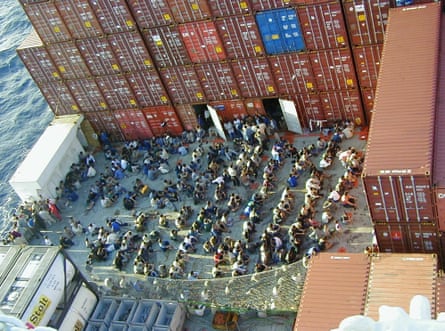
The camps were designed to be punitive and were widely promoted as a deterrent, to discourage anybody from seeking sanctuary in Australia by boat. “We will decide who comes to this country and the manner in which they come,” John Howard said as he made this policy the centrepiece of his re-election campaign. He was returned with an increased majority.
The first Nauru regime ran until 2007. The camp was bedevilled by problems: overcrowded tents and a shortage of water were the most pressing. Slowly it was established that, overwhelmingly, those who had come by boat were not “queue jumpers” or criminals or terrorists (a claim regularly made by ministers, despite being refuted by the government’s own national security chief) but rather people fleeing genuine persecution and who were owed protection. Most were resettled, and mostly in Australia. The Nauru detention regime ended in farce, with Australia at one point paying for the massive bureaucracy of an entire incarceration centre housing just two Iraqi men, both of whom were found to be refugees and were resettled.
Nauru’s second iteration as an isle of detention, instituted by a Labor government and carried on with unswerving determination by the current Liberal-National Coalition government, began in 2012. Again, an increase in the number of boats arriving – this time allied to concern about deaths at sea (not a rationale cited in 2001) – sparked a return to the former policy. Nauru and Manus, both of which had been mothballed, and condemned by the then immigration minister, Chris Evans, as “a cynical, costly and ultimately unsuccessful exercise”, were redeveloped at a cost of billions of dollars.
The problems are undiminished. But the second Nauru detention regime has been kept carefully hidden. Foreign journalists – save for a handful of selected reporters – are forbidden entry to the island. A media visa is a theoretical possibility – at the inflated price of $8,000 an application – but requests from the Guardian and other independent media organisations, even for the visa application form, are met with stony silence.
Still, some information leaks out. Refugees and asylum seekers have their communications closely monitored but still they speak out, in letters and electronic messages, in shaky, hand-held phone videos – such as the horrific footage of Omid Masoumali who, in protest against the conditions under which he is held, doused himself in petrol and set himself alight, burning to death.
Dr Peter Young, formerly the chief psychiatrist responsible for the care of asylum seekers in detention on Manus and Nauru, described the camps as “inherently toxic” and said the immigration department deliberately harmed vulnerable detainees in a process akin to torture.
Last year the government passed the Australian Border Force Act, which carries a prison sentence of up to two years for any staff member within offshore detention who makes an “unauthorised disclosure” – that is, speaks publicly about conditions inside the camps.
While the new law has had a chilling effect on some, many former and current staff continue to speak out in defiance of the law.
In June the traumatologist and psychologist Paul Stevenson told the Guardian that in 40 years working with the victims of terrorist attacks and natural disasters, the conditions in Nauru and Manus camps were the worst “atrocity” he had ever seen.
Wealth squandered
Nauru has its own complex history, a past it is trying to disentangle itself from.
The smallest island nation in the world is a bare 21 sq km – the size of an international airport – in the middle of the Pacific. Inhabited for at least 3,000 years, originally by 12 Polynesian and Micronesian tribes, its nearest neighbour, Kirabati, is 300km of empty ocean away.
A German colony in the 19th century and an Australian protectorate until the middle of the 20th, Nauru was once one of the richest places on Earth.
The island is largely made up of phosphate and in the “glory days” of the 1960s and 70s almost the entire country was stripmined for the valuable commodity, which was packed up and shipped off to be used as fertiliser around the world.
In the years post-independence in 1968, Nauru had the second-highest per-capita GDP in the world, behind only oil-rich Saudi Arabia. But the resource curse bit, and bit hard, and the money is now gone, squandered by a series of corrupt and incompetent governments who found extravagant and spectacular ways to lose the country’s wealth (including, notoriously, funding a disastrous West End musical based on the life of Leonardo da Vinci).
Nauru spent years in desperate penury. The country literally ran out of money. Its central bank went broke, its real estate overseas was repossessed, its planes seized off airport runways.
The outpost nation became a haven for money launderers – a billion dollars of Russian mafia money is estimated to have been washed through it – and its officials were reduced to selling passports.
Nauru even used its membership of the UN general assembly as a money-making exercise, accepting tens of millions of dollars in exchange for “recognising” countries, such as the Russian-backed breakaway republics Abkhazia and South Ossetia.
Its government was debased but it was Nauru’s people who suffered. Rapacious mining stripped 80% of the country, leaving it a barren moonscape of jagged rock, entirely unsuitable for agriculture, industry, forestry or even sport and recreation. When the phosphate ran out, unemployment hit 90% and the school system collapsed almost entirely, cruelling the futures of a generation.
Nauru’s land was left unusable and its people unwell – the population of 9,000 suffers extreme levels of diabetes, heart disease and obesity.
Twenty-first century Nauru, with scarce indigenous industry, is now overwhelmingly reliant on foreign aid for its economic survival. Australia is its chief and most unquestioning benefactor.
But it is not an easy relationship. Australia has rarely treated its weaker neighbour benignly. In 1993, for instance, Australia agreed to pay reparations for its mismanagement of the mining that destroyed Nauru’s natural environment (but only after Nauru took Australia to the international court of justice).
Nauru’s is a painful position for a country to be in, and vulnerability attends its weakness. The country needs Australia. As much as it might like to, it cannot say no to Australia’s comparative economic might.
It has become an archetypal “client state”.
Australia’s “proposal” of offshore processing is heard in Nauru as insistence. The government is in no position to refuse, and besides, the massive stimulus of hundreds of millions of Australian dollars, and jobs for an under-employed workforce, outweighs the fierce hostility that many – not all – in the Nauruan community hold for the refugees imposed upon their island.
Australia and Nauru, by dint of geography and history, have pasts and presents intertwined. But it is through a shared interest in the detention of asylum seekers that the two countries are now so inextricably bound.
Nauru and Australia need each other, they need the detention centre and those detained therein: one for economic survival, the other for the political expediency of “sending a message” about seeking sanctuary in this part of the world.
But both are diminished by what happens in that place. And both know it.
